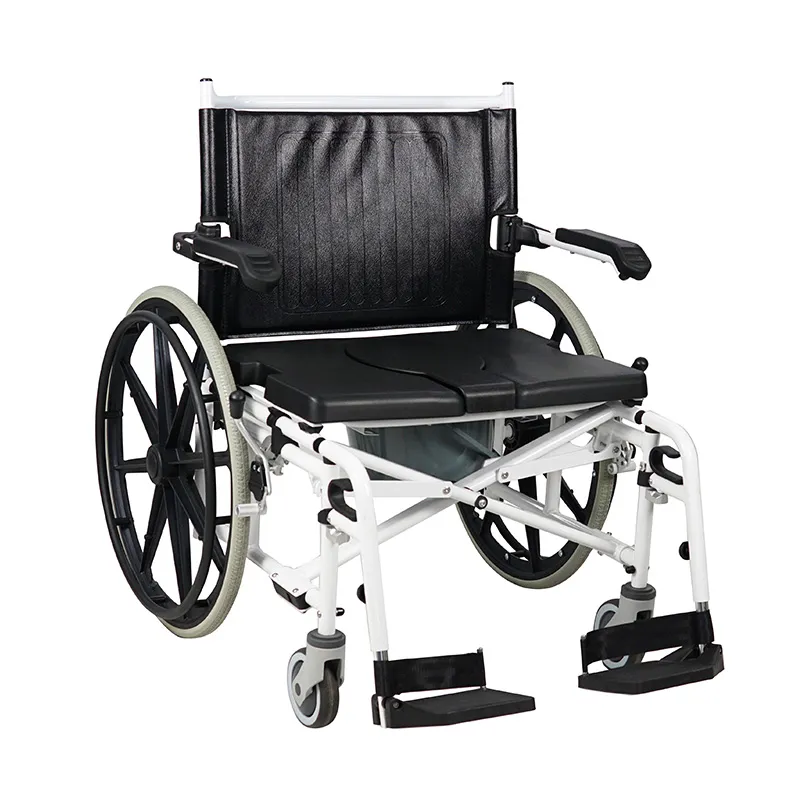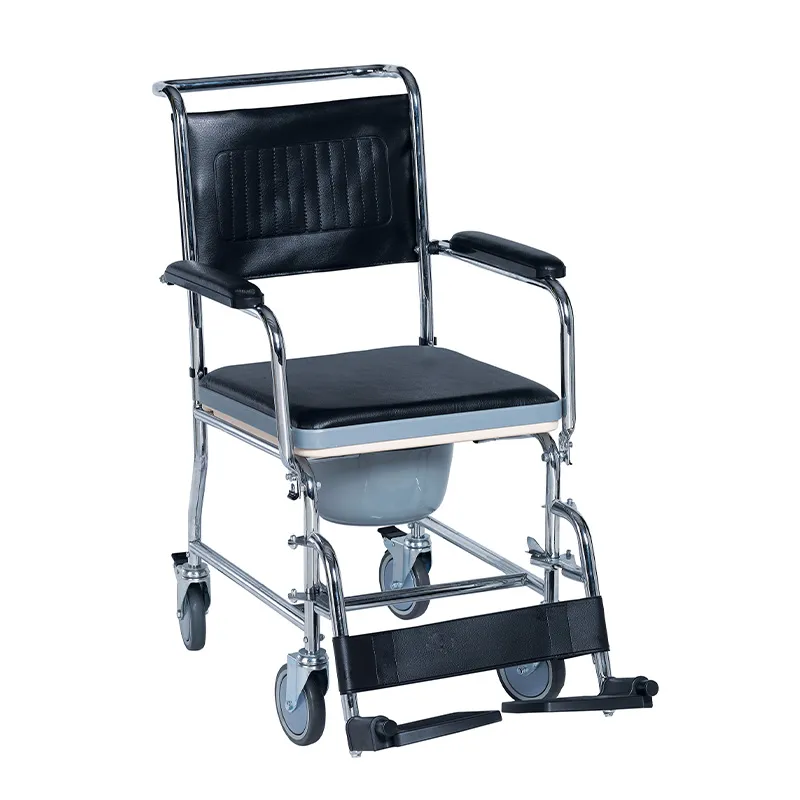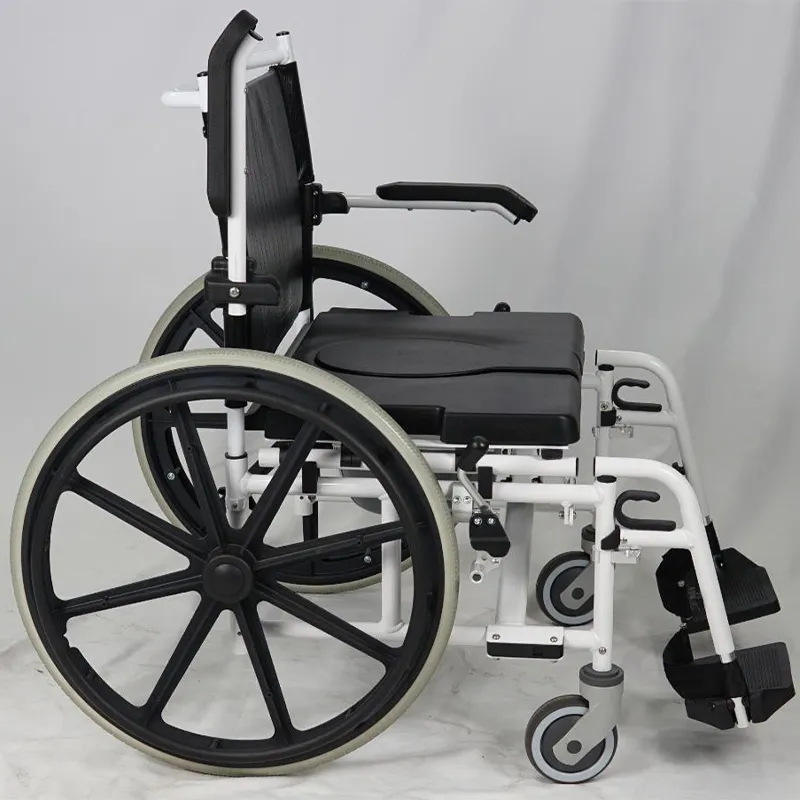
Qual è la differenza tra una sedia a rotelle da comoda e una sedia da comoda?
2024-07-17 15:30
Toilet wheelchairs and toilet chairs are common devices used to help people with mobility issues use the toilet. Although the two devices have similar names and functions, they differ significantly in design, purpose, and who they are intended for.
This article will provide an in-depth analysis of the differences between toilet wheelchairs and toilet chairs to help readers understand and correctly choose the appropriate equipment.

What is a commode wheelchair?
A commode wheelchair is a multifunctional device that combines the functions of a wheelchair and a commode chair and is specially designed for people with limited mobility. It can be used both at home and in medical institutions to help users complete toileting without leaving their wheelchair.
Toilet wheelchair design features:
1. Mobility: The toilet wheelchair is equipped with wheels for easy movement between rooms and bathrooms. Most designs have locking wheels to ensure stability during use.
2. Versatility: In addition to the toilet function, the toilet wheelchair can also be used as an ordinary wheelchair. Some premium models come with a removable commode that can be used outside the bathroom.
3. Comfort: For comfort during long-term use, commode wheelchairs usually feature cushioned seats and ergonomic designs.
4. Easy to clean: The material and structural design of the toilet wheelchair are easy to clean and disinfect, ensuring hygiene.

What is a commode chair?
A commode chair, also known as a commode chair, is a fixed commode chair primarily used in home environments. It usually has no wheels and is relatively simple in design. It is mainly used to help people with mobility issues defecate in a fixed position.
Toilet chair design features:
1. Fixability: The toilet chair usually does not have wheels and is placed in a fixed position. The user needs to move to the toilet chair by himself or with the help of others when using it.
2. Simplicity: The design is relatively simple and usually includes a seat and a commode. Some models can be placed directly above the toilet for use.
3. Comfort: Toilet chairs are generally equipped with a basic cushioned seat, and some models are equipped with armrests to increase comfort.
4. Easy to clean: The toilet bowl can be disassembled for easy cleaning and disinfection.
What is the difference between a commode wheelchair and a commode chair?
1. Differences in mobility:
● Toilet wheelchair: Equipped with wheels, it is highly mobile and can be moved freely between rooms and bathrooms. It is suitable for users who need to move frequently.
● Toilet chair: fixed in one position, mainly used for toileting in a specific location. The user needs to move to the chair by himself or with the help of others. It is suitable for users with a small range of activities.
2. Differences in versatility:
● Toilet wheelchair: Multifunctional design, it can be used as a wheelchair or commode chair, suitable for users who require comprehensive functions.
● Toilet chair: It has a single function and is mainly used for using the toilet. Some models can be placed directly above the toilet.
3. Differences in usage environment:
● Toilet wheelchair: suitable for homes and medical institutions, and can move freely between different places.
● Toilet chair: Mainly suitable for home environment, placed in a fixed position, and the use environment is relatively limited.
4. Differences in comfort and safety:
● Toilet wheelchairs: Due to their complex design, they are usually equipped with a cushioned seat and an ergonomic structure, and some models are equipped with safety belts and armrests to improve comfort and safety.
● Toilet chair: The design is relatively simple, equipped with a basic cushioned seat and armrests, and its comfort and safety are slightly lower than that of a toilet wheelchair.
5. Price difference:
● Toilet wheelchair: Due to its complex design and diverse functions, the price is usually higher and is suitable for users with higher budgets.
● Toilet chair: simple in design and relatively cheap, suitable for users with limited budget.
Who is suitable for using a commode wheelchair?
People suitable for using toilet wheelchairs include: elderly people with limited mobility, disabled people, convalescent patients, and patients with stroke or brain injury.
1. Elderly people with limited mobility:
Due to reduced mobility of the elderly, especially those suffering from osteoarthritis, rheumatism and other diseases, toilet wheelchairs provide them with support and safety when going to the toilet.
2. Disabled persons:
Disabled people with mobility impairments due to congenital or acquired reasons need toilet wheelchairs to help them complete their daily toilet needs and reduce their dependence on others.
3. Patients in recovery period:
Patients who are recovering from surgery, trauma, or illness, especially those with lower extremity limitations such as fractures or hip replacements, need to use a commode wheelchair during their recovery.
4. Patients with stroke or brain injury:
Patients with hemiplegia or total paralysis after a stroke or brain injury often require a commode wheelchair to complete activities of daily living such as going to the toilet.

Who is suitable to use a toilet chair?
People suitable for using toilet chairs include: elderly people who can move relatively freely but need support, people with temporary mobility difficulties, patients who are bedridden for a long time but can move to a fixed position, etc.
1. Elderly people who can move relatively freely but need support:
Although some elderly people have weak mobility, they are still able to move to a fixed position to use the toilet with the help of others or with assistive devices. The toilet chair provides them with basic support and comfort.
2. People with temporary mobility impairment:
Some people who have short-term mobility difficulties due to temporary conditions such as injury, postoperative recovery, etc. can also use toilet chairs. They provide temporary accommodation and support to help these people through periods of reduced mobility.
3. Patients who are bedridden for a long time but can be moved to a fixed position:
For long-term bedridden patients, especially those who can move to a fixed position with the help of others, toilet chairs provide a convenient and safe way to use the toilet.
In conclusion
Toilet wheelchairs and toilet chairs, as two important assistive devices, play an important role in helping people with mobility impairments to use the toilet.
The toilet wheelchair has strong mobility and multi-functionality and is suitable for users who require comprehensive functions; the toilet chair has a simple design and strong fixation, and is suitable for users who use the toilet in a fixed position.
We hope that the analysis and suggestions in this article can provide readers with valuable reference and help them make informed decisions when purchasing and using these assistive devices.








